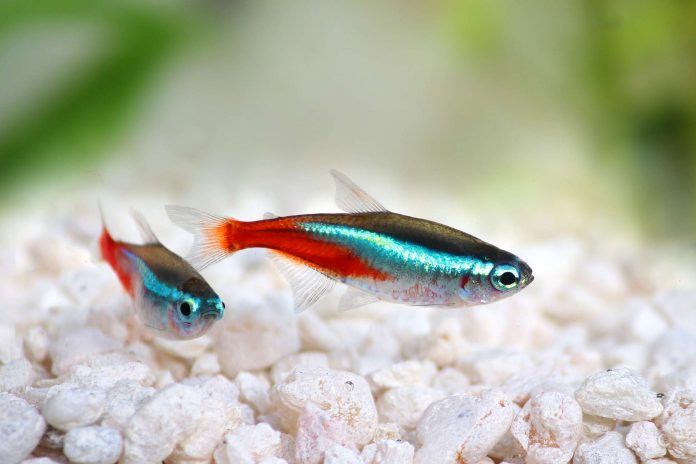Looking to get started in the freshwater aquarium hobby? It’s important to remember that starting and maintaining an aquarium can take some work, but some fish are much easier to start out with than others. Here are some of the best beginner fish to consider.
Standard Goldfish (Carassius auratus)
There are many varieties of goldfish, but beginners should start with long-body goldfish, including the comet, sarasa, and shubunkin varieties. Fancy goldfish with unusual body shapes are better for more intermediate fish-keepers. Comet goldfish can be white, orange, gold, or black, and although they start very small, can grow up to 14 inches or the size of a large dinner plate. Sarasa and shubunkin goldfish tend to stay smaller and can max out around 8 to 10 inches.
No matter which type of goldfish you choose, keep in mind that you will need 20 gallons of water per fish, just to start! As they get bigger, goldfish will need upgrades to a larger aquarium.
Goldfish, in general, are not great feed converters, so they may produce more waste than other fish. Graduate them to a pelleted diet as soon as they are big enough to eat it to reduce food waste that can produce additional ammonia.
Betta Fish (Betta splendens)
Although they have the reputation as one of the easiest fish to keep, your betta will live a longer, happier life with a few upgrades from their sad, little fishbowl.
Bettas thrive in a five-gallon tank minimum, with a filter and heater. Being tropical fish, bettas should be kept at 78 to 82 degrees Fahrenheit (26 to 28 degrees Celsius). The bigger the volume of water, the easier it is for your heater to keep a constant temperature. Make sure your aquarium has a thermometer and not those unreliable stick-on ones!
With their long, delicate fins, bettas are prone to being knocked about by quick flowing water. Use an appropriate size filter and turn the flow all the way down or divert it so your betta doesn’t get pushed around by the water flow. Their fins are easily torn on sharp decor items. If you run your finger along any potential decor, you should not feel any firm or sharp protrusions. Use decor that is betta specific if you are concerned. Keep in mind that betta fish top out length-wise around three to four inches, so make sure all their decor will suit them as they grow.
Bettas will fight with each other, so males need to be kept separated. Female bettas can usually be kept together in a large enough aquarium. For beginners, it is recommended to start with one male betta fish in his own tank. Bettas are easy to keep in a larger aquarium, and one male betta can be kept with similar-sized non-aggressive fish of other species. Extra water makes it easy for beginners to have an easy maintenance schedule. Your filter and heater will go a long way in making a happy betta home.
Be sure you don’t overfeed your betta! Their “stomach” is only about the size of their eyeball. They should never be allowed to eat their fill, but only as much food as they will eat in about 3 minutes, twice daily. Feeding quantity will depend on the size of your fish and pellet size. It is best that bettas eat betta-specific pellets in order to receive proper nutrition and the pellet size is appropriate for their mouth.
Neon Tetras (Paracheirodon innesi)
They may seem small, but a school of these brightly colored fish can look great in an aquarium. Bright streaks of blue and red make these fish a colorful addition to a community freshwater aquarium. Neon tetras tend to be very easy going and their small size makes a minimal impact on water quality.
Neon Tetras can grow to one and a half inches long. They like to school together, so start with at least three to five individuals. They are the ideal occupants for a mellow, Zen-inspired planted aquarium.
Neon tetras are easily bred in captivity, so be on the lookout for signs of inbreeding, including missing an operculum (gill cover), asymmetrical mouths, or misshapen fins. Heavily planted aquariums are needed to allow baby fish to hide and survive.
There are pelleted diets available that are small enough for Neon Tetras, but flake foods can be used as well, especially for very small fish.
Mollies & Platys (Live bearers)
Many molly and platy owners start with only one or two fish. A few weeks later, they have many fish. Live-bearing fish have this reputation, as the fish you first adopted has a 50 percent chance of being a pregnant female. Since fertilization takes place internally, you never know from the outward appearance how many fish you may be adopting. And after a single mating, a female livebearer can have multiple batches of babies!
Mollies and platys are very easy fish to care for and come in many varieties and colors. They can be kept in schools and grow to about three inches in length. We recommend starting with a common variety that is widely available, such as a black molly or red platy. Some specialty breeds, specific to only one owner or shop, tend to have inbreeding issues and they do not make good beginner fish.
Most mollies and platys are hardy and easy to keep fish. They can eat a pelleted or flake diet. It is recommended to start with a 10-gallon aquarium at a minimum, but know you may have to upgrade as your population increases.
With live-bearing fish, it is important to always plan for more fish. Even beginner fish keepers can successfully rear several generations, doubling or tripling your initial numbers within a few months. However, you will need to slow production eventually, and unmonitored breeding will cause eventual inbreeding.
Thankfully, most species are sexually dimorphic and males and females can be distinguished by external characteristics. The males have long pointed anal fins and the females have a fan-shaped anal fins. This allows you to separate males and females to keep populations from exploding. You can try a tank divider, but it is safer to put males and females in separate aquariums if you don’t want continued breeding.
Zebrafish (Danio rerio)
As their name describes, these cute, tiny fish are distinctive with their zebra-like horizontal black and white stripes along their bodies. Another fish that likes to swim in a school, zebrafish make great beginner fish. Unlike other tropical fish, zebrafish don’t require warm water temperatures. Zebrafish like cooler temperature water (around 70 degrees Fahrenheit, or 21 degrees Celsius), but you may still need a small heater to keep your aquarium from getting too cold in the winter.
Zebrafish also come in normal and longfin lengths. This species will top out at two inches long. They even come in special day-glow colors, thanks to a little genetic engineering with fluorescent jellyfish protein. These colors can be very pronounced under a blue LED light. When selecting specialized zebrafish varieties, look for individuals with straight spines and a full operculum covering their gills on both sides.
Zebrafish are great beginner pets without the hassle of keeping an eye on a heater constantly. They can eat standard tropical fish pellets or flake food. As with all other aquatic pets, perform regular filter maintenance and water changes to keep the water clean and the fish healthy.
Getting into the aquarium hobby is an exciting experience! Once you have decided on what species to keep, do your homework and plan a suitable aquarium for the fish you get. Keep in mind that all new aquariums will need to undergo nitrogen cycling before becoming established systems. By starting with a low number of fish in a lot of water, you can set yourself up for success.
































